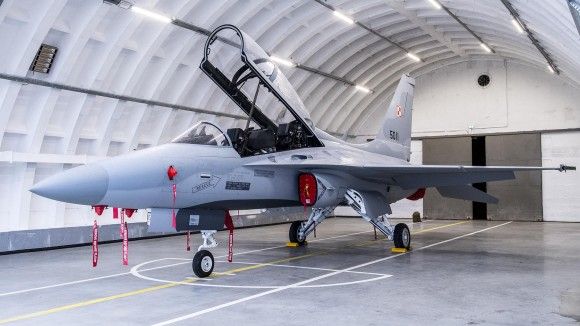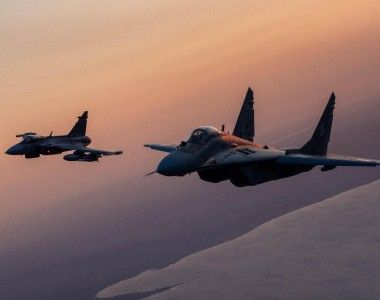Truth about the Armament for the Polish FA-50s [COMMENTARY]

Photo. ROKAF
In a parliamentary speech, Deputy Minister of Defence Cezary Tomczyk criticized the process of purchasing FA-50 aircraft, particularly the lack of weapons involved in that procurement. But was he right? Let’s look at the facts.
The Deputy Minister stated that the FA-50s are “probably the world’s first training-combat aircraft that are not combat-capable… We have a training-combat aircraft that is for training but not for combat.” From this, it seems that the planes were purchased without the armament.
The same Weapons as the F-16
Is this such a significant oversight? Different models for procuring combat aircraft exist. Our best aircraft, the F-35A, was acquired in 2020 without the ordnance (the decision was made under the same minister, Mariusz Błaszczak, who later signed the FA-50 purchase). However, the F-16C/D Jastrząb was purchased comprehensively, including weapons, munitions, targeting, and reconnaissance pods. Later, additional armament packages were ordered for them, and the Jastrząb jets were integrated with JASSM and JASSM-ER cruise missiles, ordered separately.
When we examine aircraft procurement programs pursued worldwide, the aircraft are also not always bought with ordnance. Munitions are often ordered separately. For example, the recent U.S. approval for the sale of 50 F-15IA aircraft to Israel did not include armament, only pylons for carrying it. Of course, one could argue that Israel already has armament for the F-15. Yes, but Poland… has armament for the FA-50.
Read more
Contrary to information spread in the Polish public sphere, Poland is currently able to arm the FA-50GF aircraft with several weapon systems, as it is the same weaponry we purchased for our F-16s. This includes laser-guided AGM-65 Maverick missiles, Mark 82 iron bombs, JDAM precision-guided bombs, and 20mm cannon ammunition for the M197 aircraft gun. The latter is a lighter version of the M61 Vulcan cannon used on the F-16 and utilizes the same ammunition.
In a statement to Defence24 from last fall, Lt. Col. Polak, a spokesperson for the Armament Agency, explained: „The Air Force has a stockpile of ammunition for the F-16 aircraft, of which selected types can be interchangeably used in the FA-50.” Over a decade ago, the situation was different with the purchase of the F-16, as the Jastrząb jets were the first Western combat aircraft introduced into service in the Armed Forces. The purchase of weapons integrated with American aircraft was therefore a necessity.
Of course, the weapons stockpiles that Poland purchased for the three F-16 squadrons are not sufficient for six combat aircraft squadrons (three F-16 and three FA-50), and they must be increased. However, acquiring these weapons on the market is not an issue, as it is among the most common in the world.
The only exception is the short-range air-to-air AIM-9 Sidewinder missiles. The FA-50GF is capable of using legacy variants of this missile (AIM-9L and M) that are no longer in production. These were likely the munitions Deputy Minister Tomczyk referred to when he said that the weapons for the FA-50 „can no longer be bought”.

However, it should be remembered that the FA-50GF is a transitional aircraft, which will eventually be upgraded to the PL variant. For now, it is being used for training personnel who will fly the final version, the FA-50PL. Currently, ground crews and pilots are being trained on the FA-50GF. The next 32 FA-50PL variant aircraft will be able to use the latest AIM-9X Sidewinder, a weapon available on the market and already present in Poland, as we purchased it for our F-16s.
In addition, the FA-50 will be able to use laser-guided GBU-12 bombs (also used on the Jastrząb jets) and will receive many other additional capabilities unrelated to the development of available armament (such as the PhantomStrike radar, air refueling capability, compatibility with the Sniper XR targeting and reconnaissance pod, and larger external fuel tanks).
AMRAAM’s Sin
A separate issue is the integration of the FA-50PL with medium-range AIM-120 AMRAAM air-to-air missiles. The September 2022 contract was valued at $3 billion, of which $700 million was for 12 GF variant aircraft and $2.3 billion for 32 FA-50PL jets. However, this amount did not cover two things: upgrading the first dozen aircraft from GF to PL standard and integrating the PL-standard jets with AMRAAM missiles. Despite declarations… that these missiles will be included in the FA-50PL.
The AIM-120 AMRAAM is a weapon that will significantly enhance the FA-50PL’s capabilities, allowing them to engage enemy aircraft and helicopters from a long distance in a defensive setting. This class of weapon is necessary for gaining air superiority. Meanwhile, the AIM-9X Sidewinder short-range missile is primarily a self-defense weapon or for air policing, where visual identification of an enemy aircraft is required before engaging.
Read more
Chongho Yoon, KAI Vice-President, recently told us the following, regarding the AMRAAM integration:
This requires US approval. A feasibility study is underway, all is to happen in 3-4 years. Technically this is doable, but other areas need to be addressed. KAI is currently working on such research and the matter is to be clarified in 2-3 years. KAI does know this is important.
In the author’s opinion, the AMRAAM matter is the only major omission made by the Poles, in the FA-50 procurement. Plus a lack of infrastructure investments. Without that missile, never will the FA-50s become a light multi-role combat aircraft, it will rather be viewed as a CAS platform. Briefly speaking, the FA-50, without the AIM-120, would become a successor of the Su-22, with a ground strike capability, and self-defense capability, using the short-range AAMs.
Adjustment, Not Cancelation
Minister Tomczyk does not propose to cancel the FA-50 program but to improve it. This is a wise declaration considering that the FA-50PL is set to strengthen the Air Force within 3-4 years. Abandoning the program now would delay any replacement platform until the 2030s, not to mention the enormous costs involved in such a reshuffling.
The FA-50 program has progressed too far to abandon. 12 aircraft are already in the country, pilots are being trained, and some PL variant aircraft are at various stages of production at KAI plants.

The situation could be improved by taking several simple steps. First, buy weapons for the FA-50GF (even formally as an armament package for the F-16). Second, order AMRAAM integration and politically push for this integration approval in Washington. This is not easy, but Poland could collaborate with South Korea or other interested export customers like Malaysia.
If this proves impossible, it should be remembered that KAI has good relations with European companies producing air-to-air ammunition. MBDA Meteor and IRIS-T missiles, for instance, have been integrated with another KAI aircraft: the KF-21. Integration on FA-50 should not be a problem then.
...And Justice for All
Today, it’s easy to criticize Minister Błaszczak for making the purchase „hastily,” without considering all factors, and not in as comprehensive a manner as, for example, with the F-16. However, we should remember that the F-16s were purchased at the beginning of the century when it seemed that peace would last forever, and everything could be planned slowly and calmly.
Meanwhile, the FA-50 was ordered in September 2022, and the decision-making process took place in the preceding months when the threat of imminent war loomed over Poland. The delivery timeline played a much more significant role than it does now, with the Russian forces having lost most of their equipment and predictions of war extending not for 2-3 years but nearly a decade. Even in today’s slightly better times, it’s hard not to be pleased that, thanks to that purchase, the Air Force has an additional squadron of aircraft and will gain two more within 3-4 years.
It should also be noted that Minister Błaszczak didn’t just buy “bare” aircraft. The purchase included acquiring a full mission simulator and training systems, pilot and ground crew training, consumables, and spare parts. The jets procured for the Air Force were initially intended for the Armed Forces of the Republic of Korea. This is why the delivery of simulators has been delayed — the Korean user already has them, and producing this specialized equipment takes many months.
It’s also worth noting that the infrastructure, documentation, certifications, simulators, or armament for the FA-50 are not arriving slowly. Their delivery time is within global standards and is even relatively fast. For instance, the simulator will arrive in the first quarter of 2025 — 2.5 years after the order was placed. The delivery of the first 12 aircraft was exceptionally quick, beginning less than a year after the order was placed and completed after 14 months.





